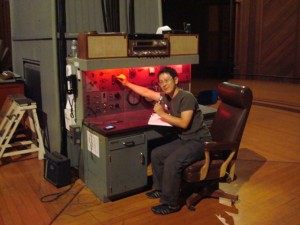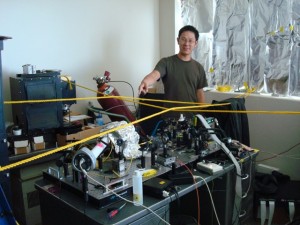FIRST@LICK: Bring the reinforcement!
FIRST@LICK: Setting up the prototype
July 25, 2010FIRST@LICK: Mounting of the prototype
August 3, 2010I mentioned in this blog that the FIRST instrument is the result of collaborations between several engineers & astronomers from everywhere in the world. On July 20, I went to the San Jose Airport near SETI Institute to meet in person for the first time in person Takayuki Kotani to give him a ride to the Lick Observatory.
Takayuki did most of his Ph.D. at the observatoire de Paris on the OHANA project (Optical Hawaiian Array for Nanoradian Astronomy) led by G. Perrin. OHANA, which means “family” in Hawaiian, consists in putting together the telescopes on the top of the Mauna Kea using fiber interferometry techniques. As a first step of this project, this group successfully linked the two W.M Keck-10m twin telescopes separated by 85m in June 2005 (Keck PR here). This is an important step since it “opens the way to sensitive optical imagers with resolutions below 1 milli-arc second” as stated by the authors in their Science paper, meaning that this method could provide a cheap way to attain an exquisite resolution by combining large aperture telescopes with an excellent sensitivity. The same team is currently trying to link two other Mauna Kea telescopes: the 3.6m-CFHT and the 8m-Gemini North Telescope.
After his Ph.D., Takayuki came back to the Observatoire de Paris at Meudon to work on the testbench of the FIRST instrument. He basically designed and built a primitive version of the prototype that we will test on the sky. He is working at JAXA, the Japanese space agency, as a postdoctoral fellow where he helps designing instruments for the SPICA Telescope, the next-generation space infrared telescope developed by JAXA in partnership with ESA.
When in January 2010, the Lick Observatory confirmed that telescope time was granted to us to test FIRST on the sky, he did not hesitate one second and he took a flight ticket to attend the run. I must mention that as soon Takayuki arrived at Lick Observatory he did not waste a second and start helping Elsa to align the prototype. The picture below shows the new set up of their “lab” where the prototype is aligned and almost ready to go on the telescope. We may have notice how they darken the room using paper foil and avoid parasite light at the entrance of the EMCCD camera with a poster tube. The yellow ropes are used as a support to protect the optics covering the entire bench with a black sheets. There is definitely a lot of creativity in this lab. 🙂
It is quite common for astronomers to juggle between several projects. Sometimes a project can remain inactive for years or we simply lose touch with it because of professional or personal reasons, then because we get funding and/or telescope time, there is a rush of activities forcing us to give up on other matters (like right now for me). We are very lucky to be able to decide our own priorities and set our schedule at work, this is a privilege that we have. A lot of us do realize that.
More news soon with the mounting of FIRST on the telescope!
F.




